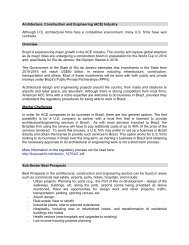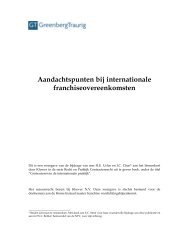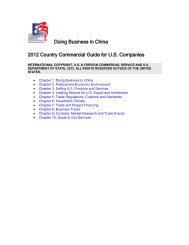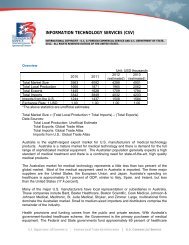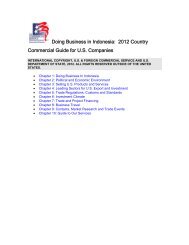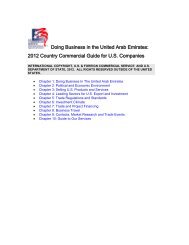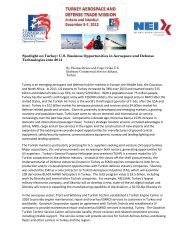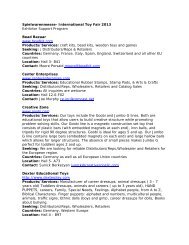CHINA: Franchising Industry - Export.gov
CHINA: Franchising Industry - Export.gov
CHINA: Franchising Industry - Export.gov
You also want an ePaper? Increase the reach of your titles
YUMPU automatically turns print PDFs into web optimized ePapers that Google loves.
US Commercial Service – The JLJ Group<br />
China <strong>Franchising</strong> <strong>Industry</strong><br />
Page 2 of 23<br />
INDUSTRY OVERVIEW Return to Top<br />
Market overview. China has 2,600 franchise networks 4 operating in the first quarter of 2007 and over<br />
200,000 franchised outlets. However, many of these franchises are domestic brands and small in scale,<br />
with an average of 73 outlets per franchise brand 5 , compared to over 540 in the US. The limited use of<br />
franchised stores also reflects the key challenges to adopt this model, for example, regional differences<br />
and quality of local franchisees/partners.<br />
Market growth. Growth in sales from franchised stores has averaged 35-40% in the last few years. In<br />
2006, sales from franchised outlets grew by 40%, compared to 10% for retail outlets in general.<br />
Currently, franchising in China only accounts for 3% of total retail sales – compared to 40% in the US<br />
and about 10% on average in Europe. Thus, there is still significant growth potential in franchising.<br />
Drivers of growth. On the demand side, growth is driven by an expanding consumer market, a<br />
developing urban middle class, rising disposable incomes, and changing customer attitudes. On the<br />
supply side, an increasing number of Chinese companies are using the franchising model to expand.<br />
Also, more Chinese entrepreneurs are willing to be franchisees for foreign brands, and have the<br />
financial resources to do so. In addition, the Chinese market has become more attractive to foreign<br />
franchisors since the regulations newly introduced in March 2007 address many previous issues that<br />
were unclear in the previous regulations. [see section on Regulatory Environment for more details.]<br />
Key sectors. The franchising model is adopted in over 80 sectors. In 2005, 34% of franchised stores<br />
were in food and catering, 31% in retailing, and 35% in the service (includes laundry, property agents,<br />
copy-shops, etc.) sector. Companies with existing chain stores 6 have used franchising to expand – 69%<br />
of chains adopted the franchising model at the start of 2007. In particular, fast food chains rely heavily<br />
on franchising – 95% have used franchising to expand.<br />
35%<br />
Franchised Stores by Sector<br />
34%<br />
Source: Ministry of Commerce<br />
31%<br />
Retail<br />
Food & Catering<br />
Services<br />
Regulatory Environment Return to Top<br />
Regulatory developments. China’s first franchise law was enacted in 1997 by the Ministry of Domestic<br />
Trade, which did not make clear provisions for foreign companies. In 2005, the Ministry of Commerce<br />
(MOFCOM) released hastily – due to WTO commitments – drafted measures applicable specifically to<br />
foreign franchisors. This document confirmed that foreign companies must establish a legal entity in<br />
China before they can engage in franchising; however many other issues were still unclear, including<br />
the legality of cross-border franchising. In March 2007, further updates (“The Regulations”, “The Record<br />
Filing Measures” and “The Information Disclosure Measures”) to the existing regulations were<br />
announced, which addressed many of the grey areas. These new amendments form the new regulatory<br />
framework for franchising. The following are the most important aspects of the updated regulation. It<br />
must be noted that these May 2007 regulations are still relatively new, and more time is needed to see<br />
the actual implementation.<br />
4 Refers to a system of franchisees under the same network. A franchise brand may have more than one franchise network, e.g. it has a few<br />
regional master franchisees, which in turn further sub-franchise.<br />
5 Includes China’s large franchise brands, with thousands of outlets, as well as the multitude of small brands, with only a few outlets each.<br />
6 While franchises are always chain stores, the opposite does not hold true.





